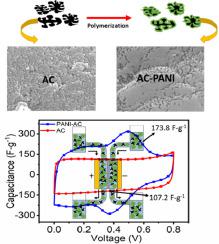Electrochimica Acta ( IF 5.5 ) Pub Date : 2020-07-07 , DOI: 10.1016/j.electacta.2020.136719 Pushpendra Singh , Kaushik Pal

|
Conducting polymer polyaniline (PANI) offers very high capacitance but suffers from poor cycling stability. On the other hand, electrochemical flow capacitor (EFC) systems allow replacement of electrode slurry materials whenever needed. Thus using polyaniline as active material in slurry for EFC system can enhance the performance of suspension electrode, and the flow system can itself resolve the issue of poor cyclic stability of polyaniline by replacing it with new fresh slurry whenever it decomposes. However, pristine polyaniline slurry in the flow system is highly prone to decomposition. Hence an activated carbon-polyaniline (AC-PANI) composite active material has been prepared. The porous structure of activated carbon (AC) helps in holding polymer chains upon successive cycling. AC-PANI composite in slurry results in improved capacitive performance 173.8 F-g−1 (139.04 C-g−1) @ 2 mV-s−1 during static slurry testing. After 200 cycles @ 20 mV-s−1, the AC-PANI composite slurry holds 91% capacitance. In the flow test, the composite slurry demonstrates 48% improvement in volumetric capacitance as compared to pristine AC slurry. In addition to this, AC-PANI composite slurry exhibits a gravimetric energy density of 15.46 Wh-kg−1 in static slurry testing mode and a volumetric energy density of 0.43 Wh-L−1 during the intermittent flow test. Moreover, AC-PANI composite slurry also has lower viscosity comparative to pristine AC slurry under the same mass loading. In this way, this AC-PANI composite enjoys the benefit of improved capacitive performance with better rheological behavior for suspension electrode.
中文翻译:

活性炭-聚苯胺复合活性材料浆料电极,具有高电容,改善了流变性能,电化学流量电容器
导电聚合物聚苯胺(PANI)具有很高的电容,但循环稳定性差。另一方面,电化学流电容器(EFC)系统允许在需要时更换电极浆料材料。因此,在EFC系统的浆料中使用聚苯胺作为活性材料可以增强悬浮电极的性能,并且流动系统可以通过在分解时用新的新鲜浆料代替聚苯胺来解决聚苯胺循环稳定性差的问题。但是,流动系统中的原始聚苯胺浆料极易分解。因此,已经制备了活性炭-聚苯胺(AC-PANI)复合活性材料。活性炭(AC)的多孔结构有助于在连续循环后保持聚合物链。在静态浆料测试期间,g -1(139.04 C- g -1)@ 2 mV- s -1。在20 mV- s -1下200次循环后,AC-PANI复合浆料保持91%的电容。在流动测试中,与原始AC浆料相比,复合浆料的体积电容提高了48%。除此之外,AC-PANI复合浆料在静态浆料测试模式下的重量能量密度为15.46 Wh-kg -1,体积能量密度为0.43 Wh- L -1在间歇流量测试中。此外,在相同的质量负载下,AC-PANI复合浆料的粘度也比原始AC浆料低。这样,这种AC-PANI复合材料的优点是改进了电容性能,同时悬浮电极的流变性更好。











































 京公网安备 11010802027423号
京公网安备 11010802027423号